Text
How many have you read?
The BBC estimates that most people will only read 6 books out of the 100 listed below. Reblog this and bold the titles you’ve read.
1 Pride and Prejudice - Jane Austen
2 Lord of the Rings - J. R. R. Tolkein
3 Jane Eyre – Charlotte Bronte
4 Harry Potter series
5 To Kill a Mockingbird - Harper Lee
6 The Bible
7 Wuthering Heights – Emily Bronte
8 Nineteen Eighty Four – George Orwell
9 His Dark Materials – Philip Pullman
10 Great Expectations – Charles Dickens
11 Little Women – Louisa M Alcott
12 Tess of the D’Urbervilles – Thomas Hardy
13 Catch 22 – Joseph Heller
14 Complete Works of Shakespeare
15 Rebecca – Daphne Du Maurier
16 The Hobbit – JRR Tolkien
17 Birdsong – Sebastian Faulks
18 Catcher in the Rye
19 The Time Traveller’s Wife - Audrey Niffeneger
20 Middlemarch – George Eliot
21 Gone With The Wind – Margaret Mitchell
22 The Great Gatsby – F Scott Fitzgerald
23 Bleak House – Charles Dickens
24 War and Peace – Leo Tolstoy
25 The Hitch Hiker’s Guide to the Galaxy – Douglas Adams
26 Brideshead Revisited – Evelyn Waugh
27 Crime and Punishment – Fyodor Dostoyevsky
28 Grapes of Wrath – John Steinbeck
29 Alice in Wonderland – Lewis Carroll
30 The Wind in the Willows – Kenneth Grahame
31 Anna Karenina – Leo Tolstoy
32 David Copperfield – Charles Dickens
33 Chronicles of Narnia – CS Lewis
34 Emma – Jane Austen
35 Persuasion – Jane Austen
36 The Lion, The Witch and The Wardrobe – CS Lewis
37 The Kite Runner - Khaled Hosseini
38 Captain Corelli’s Mandolin - Louis De Bernieres
39 Memoirs of a Geisha – Arthur Golden
40 Winnie the Pooh – AA Milne
41 Animal Farm – George Orwell
42 The Da Vinci Code – Dan Brown
43 One Hundred Years of Solitude – Gabriel Garcia Marquez
44 A Prayer for Owen Meaney – John Irving
45 The Woman in White – Wilkie Collins
46 Anne of Green Gables – LM Montgomery
47 Far From The Madding Crowd – Thomas Hardy
48 The Handmaid’s Tale – Margaret Atwood
49 Lord of the Flies – William Golding
50 Atonement – Ian McEwan
51 Life of Pi – Yann Martel
52 Dune – Frank Herbert
53 Cold Comfort Farm – Stella Gibbons
54 Sense and Sensibility – Jane Austen
55 A Suitable Boy – Vikram Seth
56 The Shadow of the Wind – Carlos Ruiz Zafon
57 A Tale Of Two Cities – Charles Dickens
58 Brave New World – Aldous Huxley
59 The Curious Incident of the Dog in the Night-time – Mark Haddon
60 Love In The Time Of Cholera – Gabriel Garcia Marquez
61 Of Mice and Men – John Steinbeck
62 Lolita – Vladimir Nabokov
63 The Secret History – Donna Tartt
64 The Lovely Bones - Alice Sebold
65 Count of Monte Cristo – Alexandre Dumas
66 On The Road – Jack Kerouac
67 Jude the Obscure – Thomas Hardy
68 Bridget Jones’s Diary – Helen Fielding
69 Midnight’s Children – Salman Rushdie
70 Moby Dick – Herman Melville
71 Oliver Twist – Charles Dickens
72 Dracula – Bram Stoker
73 The Secret Garden – Frances Hodgson Burnett
74 Notes From A Small Island – Bill Bryson
75 Ulysses – James Joyce
76 The Bell Jar – Sylvia Plath
77 Swallows and Amazons - Arthur Ransome
78 Germinal – Emile Zola
79 Vanity Fair – William Makepeace Thackeray
80 Possession – AS Byatt
81 A Christmas Carol – Charles Dickens
82 Cloud Atlas – David Mitchel
83 The Color Purple – Alice Walker
84 The Remains of the Day – Kazuo Ishiguro
85 Madame Bovary – Gustave Flaubert
86 A Fine Balance – Rohinton Mistry
87 Charlotte’s Web – EB White
88 The Five People You Meet In Heaven – Mitch Albom
89 Adventures of Sherlock Holmes – Sir Arthur Conan Doyle
90 The Faraway Tree Collection – Enid Blyton
91 Heart of Darkness – Joseph Conrad
92 The Little Prince – Antoine De Saint-Exupery
93 The Wasp Factory – Iain Banks
94 Watership Down – Richard Adams
95 A Confederacy of Dunces – John Kennedy Toole
96 A Town Like Alice – Nevil Shute
97 The Three Musketeers – Alexandre Dumas
98 Hamlet – William Shakespeare
99 Charlie and the Chocolate Factory – Roald Dahl
100 Les Miserables – Victor Hugo
71K notes
·
View notes
Text
[sexting] no live organism can continue for long to exist sanely under conditions of absolute reality; even larks and katydids are supposed, by some, to dream. Hill House, not sane, stood by itself against its hills, holding darkness within; it had stood for eighty years and might stand for eighty more. within, walls continued upright, bricks met neatly, floors were firm, and doors were sensibly shut; silence lay steadily against the wood and stone of Hill House, and whatever walked there, walked alone.
547 notes
·
View notes
Text
#It's Very Important that Irish breakfast tea#Is not the same as English breakfast tea#Not just becuase colonialism#Irish breakfast tea is stronger and maltier#Every time I have English breakfast I'm like who watered down my tea#But also#Oolong#Runner up
8K notes
·
View notes
Text
so you read the táin, what next?
táin bó cúailnge is a great starting place if you’re interested in medieval irish lit. it’s famous for a lot of reasons – its length, its quality, the fact that there are good, accessible modern translations available… definitely a go-to if people want to know where to start
but say you’ve read the táin, and maybe you’ve even read the remscéla (fore-tales, prequels), and you know there’s a shitton of other material out there but you have no idea what direction to go in
here are my recommendations for
what medieval irish text should you read next based on which bits of the táin you liked most
a non-exhaustive* and extremely biased list**
*I may or may not make further recommendations at some stage.
**i tried to minimise the ulster cycle content here bc that seems like an obvious jumping off point and you’re probably here for Weird Shit but there’s still some ulster cycle bc i like it
if you were intrigued by the hints of supernatural fuckery going on in the background but still like having some humans around -> togail bruidne da derga (the destruction of da derga’s hostel)
if you have no interest in humans and just want supernatural fuckery all the way down -> cath maige tuired (the second battle of moytura)
if the ríastrad/warp-spasm gets you excited ;) and you want more body horror and weird creatures -> immram curaig mael duin (the voyage of mael duin). or pretty much any voyage text but mael duin has some of the fuckier creatures in it
if you’re like “yeah! medb DID effectively utilise girl power!” and/or just really want to see cú chulainn getting beaten up -> serglige con culainn (the wasting sickness of cú chulainn)
if you’re into the geography of it and how events relate to place names and histories -> this is called ‘dindshenchas’, the lore of place-names, and there are whole collections of just this, but you might also like acallam na senorach (tales of the elders of ireland) which is that but with a frame-story around it, featuring st patrick on a road trip with the last of the fíanna
if you read the mustering of the ulaid and were like “oh hey a big-ass list of names? i LOVE a big-ass list of names! give me all the names!” -> lebor gabala erenn (the book of invasions). alternatively, dindshenchas.
if you cried over the fight with fer diad and generally enjoyed having Feelings -> well, ideally, early modern prose texts (FULL of feelings), but since there are minimal translations of those available, consider longes mac nuislenn, oidheadh chloinne lir, or anything with the word “aided” or “oidheadh” in the title (it means “violent/tragic death”)
if you like the references to classical texts that happen now and again -> merugud uilix meic laertis (the wanderings of ulysses son of laertes), aka the medieval irish retelling of the odyssey, which bears no resemblance to the odyssey; OR togail troí (the destruction of troy), the irish retelling of the trojan war that had a noticeable influence on the táin (togail troí is more relevant, merugud uilix is funnier)
if you like it when people insult/trash-talk each other -> scela mucce meic datho (the story of mac datho’s pig)
if you just really want to know what the fuck is going on with the bulls -> echtra nera (the adventure of nera). this is only one version of the backstory but it has some cool supernatural fuckery in it so what’s not to like
if you want more láeg/cú chulainn content -> tóraigheacht gruaidhe griansholas (the pursuit of gruaidh griansholas), which is a late text featuring excellent láeg moments
this has been: 2am medieval lit recommendations with néide, your host. tune in tomorrow and i might actually give you links to help with finding these. have fun.
edit: now updated with links. where possible i have provided a link to read the text free and legally online. some are pdfs, some are archive.org, some are just text. two exceptions: tales of the elders of ireland is a very recent translation and is not available legally online; link is an affiliate link to amazon, so if you buy it via that link, i get a few pennies. i recommend supporting your local libraries and bookshops if you can tho. dillon’s translation of serglige con culainn is also not available online that i could find; link is to a scan. it was published in the 50s so may not be *quite* out of copyright yet but close enough i hope. (quality is not great as i had to compress it.)
373 notes
·
View notes
Text

And then there shall be a fire that knows the naming of you, and in the presence of the strangling fruit, its dark flame shall acquire every part of you that remains.
#my art#illustration#fanart#dungeon meshi#delicious in dungeon#Annihilation#the southern reach trilogy#This took way too long for how little I like the end result
65 notes
·
View notes
Text
I know I'm friends at the table brained but this is so Ali-coded to me. Kabru is one of her characters I feel it in my bones
there’s something wrong with him
5K notes
·
View notes
Text
This comic is up there in the running for favourite Dungeon Meshi omake for sure for sure. The way that it explodes simple binaries in favour of a more complex reality is just a perfect summation of what Ryoko Kui is constantly doing with this series.
I love how it is not neatly resolved or resolvable what is what. The elderly dwarf in Namari's imagination doesn't have a ton of facial hair, but is that the typical amount? Do some dwarf women grow full beards? What percentage has what? And then flipping it around to tall-man women - which is obviously true irl, lots of women both cis and trans grow facial hair to varying degrees and have to shave, but it's not clear if Namari understands that or if she's making an assumption based on her own experiences. Like, Falin probably doesn't have to shave because she's fair haired and pale skinned, but that doesn't mean Namari is wrong.
It's so unbelievably efficient about adding layers to the concept of dwarf women growing beards, which can be kind of a goofy fantasy joke. I am in awe of how much information is in these eight panels.
And then it just ends on that great joke about elf nose hair, shoutouts.

Dungeon Meshi - Female Dwarf beards
2K notes
·
View notes
Text
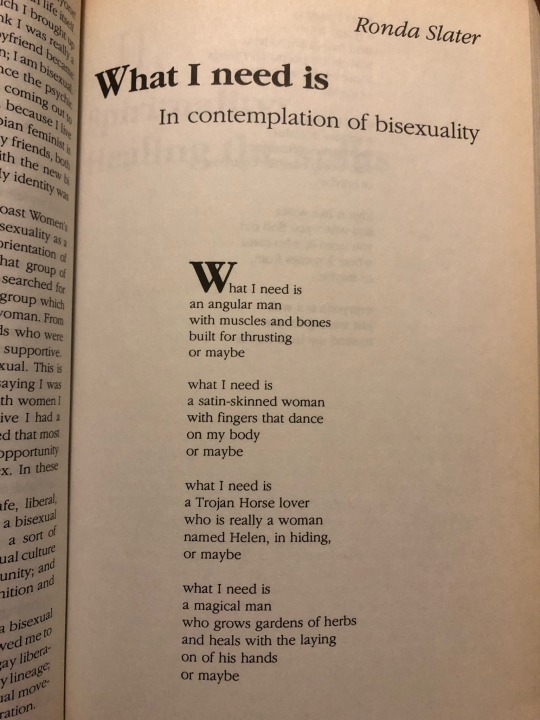
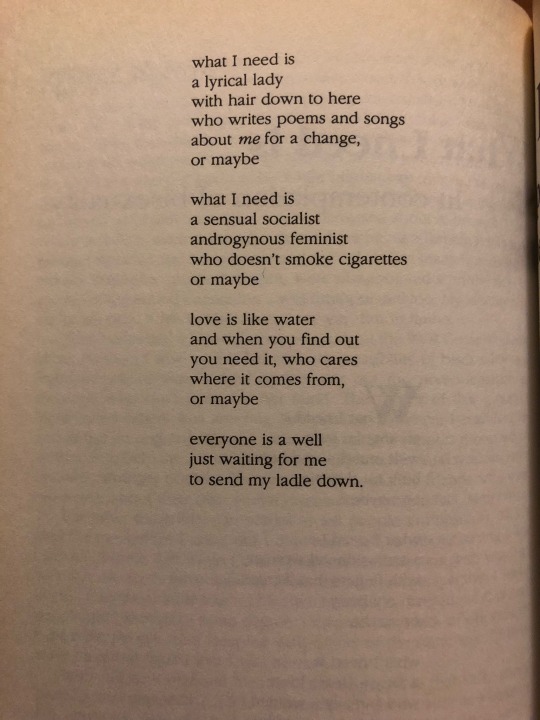
ronda slater, what I need is: a contemplation of bisexuality, from bi any other name: bisexual people speak out, edited by Lorraine Hutchins and Lani Kaahumanu, 1991
28K notes
·
View notes
Text
Captains in perfect millennium 1432 can't mourn, all they know is text emojis, explode they scouter, expand polycule, eat hot chip and lie
Brnine, learn to mourn I'm begging you
122 notes
·
View notes
Text
Y'know I'm in no way actually against arranged marriage plots.
But, like, I inevitably end up getting pretty wild whiplash at the number of people who write them as a convenient meet cute for a romantic wish fulfillment thing and not (as I hope and expect) a fucked up mutual tragedy.
Like I'm not hallucinating here the conventional happy romance role of the arranged marriage is 'looming Sword of Damocles heroine escapes by eloping with her actual lover', right? I'm just getting a biased sample here?
113 notes
·
View notes
Text
You know what really fucking Annoys Me about internet censorship is stuff like swear words being heavily censored because that's entirely an American cultural hangup being forced on the rest of us. I don't know a single country where swearing is as taboo as it is in America. In fact most languages have swear words that would have the same effect on an American as giving a Victorian chimney sweep a pepsi max cherry.
76K notes
·
View notes
Text
Here's the time lapse for the cori fanart. I will be somewhat amazed if tumblr actually allows this upload tbh.
#my art#illustration#fanart#friends at the table#palisade#palisade spoilers#coriolis sunset#time lapse
16 notes
·
View notes
Text

"And Cori is crying these big studio ghibli tears"
A redraw of the haku/chihiro scene with cori and Perennial. The wings are referenced from howl's moving castle, and in general I plucked a lot of colours from the ghibli references as well, because colour is my biggest weak point.
Don't zoom in too close or you'll see how messy this really is, even with all the corners I cut it took so long sob sob sob. This is why visual media don't usually have one of the characters be a disembodied nervous system made of Russian sage (shoutouts to Austin for specifically emphasising that on the pod. Ha. Haha.)
I hope the head wings are somewhat visually distinct from the back wings, but they might not be.
I kind of want to upload the time lapse video for this one, but it's like 5 mins long and over 50mb so I'd have to put it on youtube or something I think. Which is a whole kettle of fish.
(the quote at the top might not be exact, the transcript isn't out yet and I didn't go back to listen and check)
98 notes
·
View notes
Text
realities, maximalism,and the need for big book™️
some gubat banwa design thoughts vomit: since the beginning of its development i've kind of been enraptured with trying to really go for "fiction-first" storytelling because PbtA games really are peak roleplaying for me, but as i wrote and realized that a lot of "fiction first" doesn't work without a proper sort of fictional foundation that everyone agrees on. this is good: this is why there are grounding principles, genre pillars, and other such things in many PbtA games--to guide that.

broken worlds is one of my favs bc of sheer vibes
Gubat Banwa didn't have much in that sense: sure, I use wuxia and xianxia as kind of guideposts, but they're not foundational, they're not pillars of the kind of fiction Gubat Banwa wants to raise up. there wasn't a lot in the sense of genre emulation or in the sense of grounding principles because so much of Gubat Banwa is built on stuff most TTRPG players haven't heard about. hell, it's stuff squirreled away in still being researched academic and anthropological circles, and thanks to the violence of colonialism, even fellow filipinos and seasians don't know about them
this is what brought me back to my ancient hyperfixations, the worlds of Exalted, Glorantha, Artesia, Fading Suns... all of them have these huge tomes of books that existed to put down this vast sprawling fantasy world, right? on top of that are the D&D campaign settings, the Dark Suns and the Eberrons. they were preoccupied in putting down setting, giving ways for people to interact with the world, and making the world alive as much as possible.
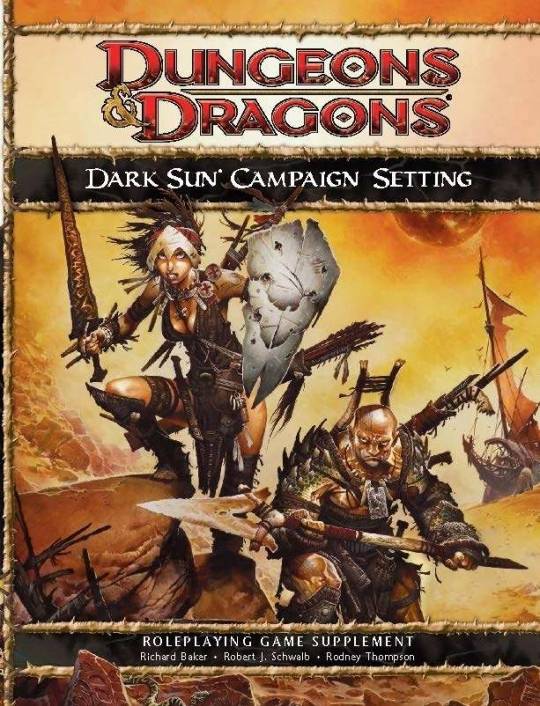



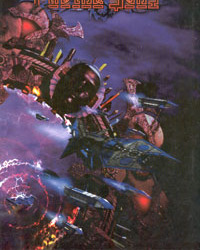
one of my main problems with gubat banwa was trying to convey this world that i've seen, glimpsed, dreamed of. this martial fantasy world of rajas and lakans, sailendras and tuns, satariyas and senapatis and panglimas and laksamanas and pandai... its a world that didn't really exist yet, and most references are steeped in either nationalism or lack of resources (slowly changing, now)

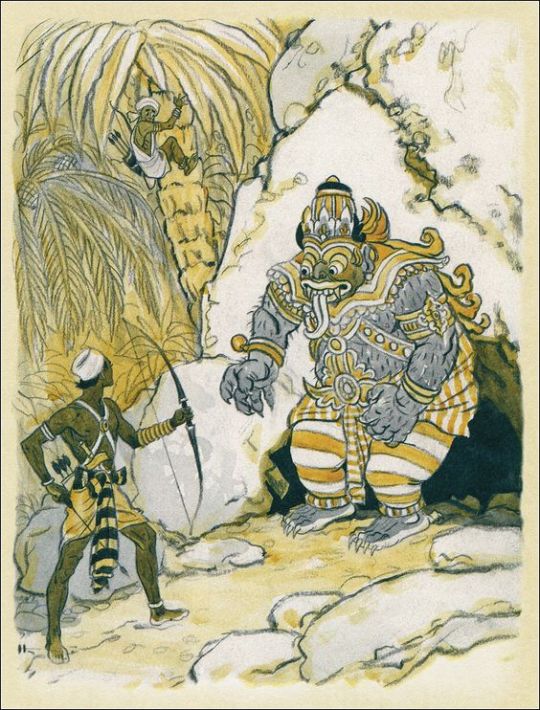
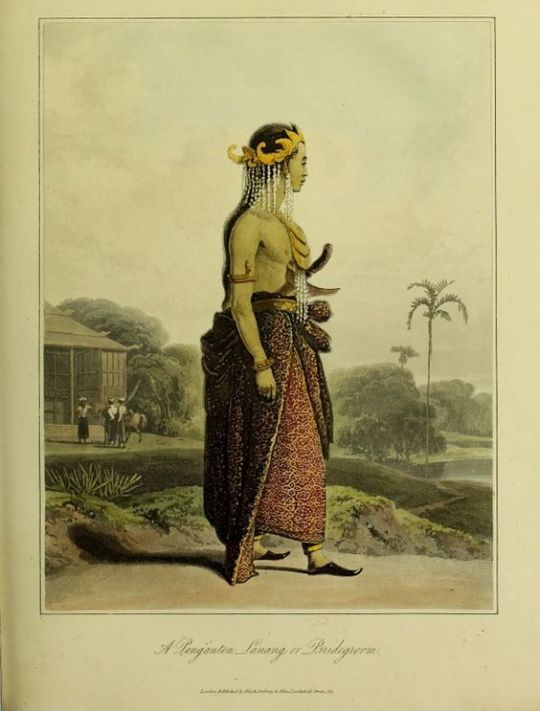
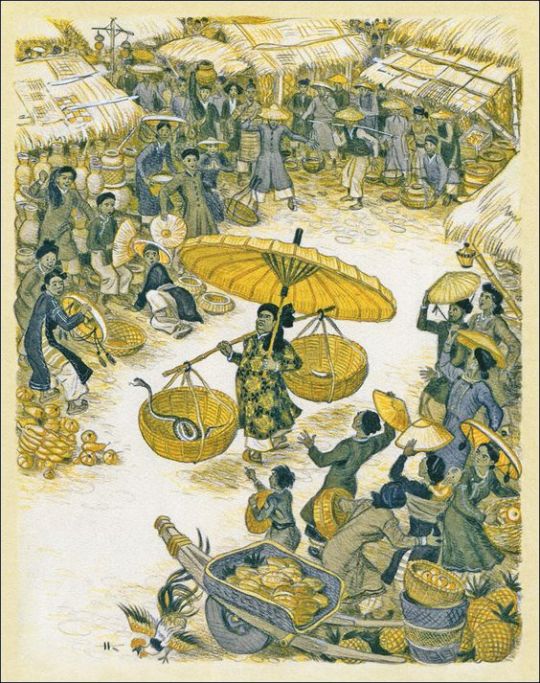
i didn't want to fall back into the whole gazeteer tourist kind of shit when it came to writing GB, but it necessitated that the primary guidelines of Gubat Banwa were set down. my approach to it was trying to instill every aspect of the text, from the systems to the fluff text to the way i wrote to the way things were phrased, with the essence of this world i'm trying to put forward. while i wrote GB mainly for me and fellow SEAsian people, economically my main market were those in the first world countries that could afford to buy the book. grokking the book was always going to be severely difficult for someone that didn't have similar cultures, or are uninterested in the complexities of human culture. thus why GB had to be a big book.
in contemporary indie ttrpg spaces (where I mostly float in, though i must admit i pay more attention to SEAsia spaces than the usual US spaces) the common opinion is that big books like Exalted 3e are old hat, or are somewhat inferior to games that can cram their text into short books. i used to be part of that camp--in capitalism, i never have enough time, after all. however, the books that do go big, that have no choice to go big, like Lancer RPG, Runequest, Mage, Exalted are usually the ones that have something really big it needs to tell you, and they might be able to perform the same amount of text-efficient bursting at the seams flavor writing but its still not enough.
thats what happened to GB, which I wanted to be, essentially, a PbtA+4e kind of experience, mechanically speaking. i very soon abandoned those titles when i delved deeper into research, incorporated actual 15th century divination tools in the mechanics, injected everything with Martial Arts flavor as we found our niche
all of this preamble to say that no matter how light i wanted to go with the game, i couldnt go too light or else people won't get it, or i might end up writing 1000 page long tome books explaining every detail of the setting so people get it right. this is why i went heavy on the vibes: its a ttrpg after all. its never gonna be finished.
i couldnt go too light because Gubat Banwa inherently exists on a different reality. think: to many 3 meals a day is the norm and the reality. you have to eat 3 meals a day to function properly. but this might just be a cultural norm of the majority culture, eventually co opted by capitalism to make it so that it can keep selling you things that are "breakfast food" or "dinner food" and whatnot. so its reality to some, while its not reality to others. of course, a lot of this reality-talk pertains mostly to social--there is often a singular shared physical reality we can usually experience*
Gubat Banwa has a different fabric of reality. it inherently has a different flow of things. water doesn't go down because of gravity, but because of the gods that make it move, for example. bad things happen to you because you weren't pious or you didn't do your rituals enough and now your whole community has to suffer. atoms aren't a thing in gb, thermodynamics isn't a real thing. the Laws of Gubat Banwa aren't these physical empirical things but these karmic consequent things
much of the fiction-first movement has a sort of "follow your common sense" mood to it. common sense (something also debatable among philosophers but i dont want to get into that) is mostly however tied to our physical and social realities. but GB is a fantasy world that inherently doesn't center those realities, it centers realities found in myth epics and folk tales and the margins of colonized "civilization", where lightnings can be summoned by oils and you will always get lost in the woods because you don't belong there.
so Gubat Banwa does almost triple duty: it must establish the world, it must establish the intended fiction that arises from that world, and then it must grant ways to enforce that fiction to retain immersion--these three are important to GB's game design because I believe that that game--if it is to not be a settler tourist bonanza--must force the player to contend with it and play with it within its own terms and its own rules. for SEAsians, there's not a lot of friction: we lived these terms and rules forever. don't whistle at night on a thursday, don't eat meat on Good Friday, clap your hands thrice after lighting an incense stick, don't make loud noise in the forests. we're born into that [social] reality
this is why fantasy is so important to me, it allows us to imagine a different reality. the reality (most of us) know right now (i say most of us because the reality in the provinces, the mountains, they're kinda different) is inherently informed by capitalist structures. many people that are angry at capitalist structures cannot fathom a world outside capitalist structures, there are even some leftists and communists that approach leftism and revolution through capitalism, which is inherently destructive (its what leads to reactionaries and liberalism after all). fantasy requires that you imagine something outside of right now. in essence read Ursula K Le Guin
i tweeted out recently that you could pretty easily play 15-16th century Luzon or Visayas with an OSR mechanic setting and William Henry Scott's BARANGAY: SIXTEENTH CENTURY PHILIPPINE CULTURE AND SOCIETY, and I think that's purely because barebones OSR mechanics stuff fits well with the raiding and adventuring that many did in 15-16th century Luzon/Visayas, but a lot of the mechanics wont be comign from OSR, but from Barangay, where you learn about the complicated marriage customs, the debt mechanics, the social classes and stratum...
so thats why GB needs to be a (relatively) big book, and why I can contend that some books need to be big as well--even if their mechanics are relatively easy and dont need more than that, the book, the game, might be trying to relay something even more, might be trying to convey something even more than that. artesia, for example, has its advancements inherently tied to its Tarot Cards, enforcing that the Arcana guides your destiny. runquest has its runes magic, mythras (which is kinda generic) has pretty specific kinds of magic systems that immediately inform the setting. this is why everything is informed by something (this is a common Buddhist principle, dependent arising). even the most generic D&D OSR game will have the trappings of the culture and norms of the one that wrote and worked on it. its written from their reality which might not necessarily be the one others experience. that's what lived experience is, after all
*live in the provinces for a while and you'll doubt this too!
337 notes
·
View notes
Text
astonished, truly ASTONISHED, that brnine's vision of the future wasn't their own funeral. Because that's what they want, isn't it? Not to keep fighting forever but to die fighting, and in that have their death mean something, and get to finally put down everything they've been carrying (sorry brnine I want you to live forever)
perennial continues to be just my absolute favourite I love her so much I'm so glad one of the charcaters is continuing to have a connection with her.
22 notes
·
View notes
Text
I think the anime should take a third run at thistle/sissel discourse and call him Cecil.
76 notes
·
View notes
Text


I'm not gonna have time to do a full drawing today, and I'm on a train which makes smooth lines really tricky, so here's a super rough concept of a lyke card, plus the seven different iterations of the hanged man that I own from different sets.
I think it's very funny that everyone went for the hanged man as their tarot card, but it is the one that Keith and Austin chose for lyke, so I felt obliged.
The hanged man is a great card, deeply ambiguous. It's sometimes read as a traitor, or a mystic, or a version of odin. The figure hangs in this deeply ambiguous point between passivity and active choice. It's meant to be unclear whether they have been placed in this situation and are trapped, or whether this is an active decision to reach enlightenment. I want to evoke all those elements with Lyke, and lean into the uncertainty of his choices, which is why there's a shrew skull in the lower left corner, for chine. Roses, naturally, for Aterika'kaal - and rose thorns binding lyke's foot to the beam. The ravening beast appears from behind his coat, and tombo in its bowl is between his hands, which are stained with spider ink. Tombo is drawn to deliberately echo one half of the "two fish as yin and yang" image that is so popular, which is extremely corny but I like the idea of it feeling like something out of balance, that there's a missing presence. I might try and add a few more details, like junk spilling out of lyke's pockets, and some element of fire somewhere. He has one eye closed as a deliberate evocation of odin, because doing something stupid in the pursuit of knowledge is very lyke.
The cards in the picture on the right are from seven different decks - centre is the thoth tarot deck, centre top is the little monsters deck, and then going clockwise it's the corrupted tarot deck by wyrmwood, the star spinner tarot, the botanica tarot, the crow tarot and the literary tarot. If you're curious about any of those decks I wrote up a big post on all of them that you can find on this blog. But it's fun to look at all of them together and see the consistencies as well as the variations.
#friends at the table#illustration#my art#fanart#sangfielle#lye lychen#Tarot#The hanged man#15 days of fatt
18 notes
·
View notes